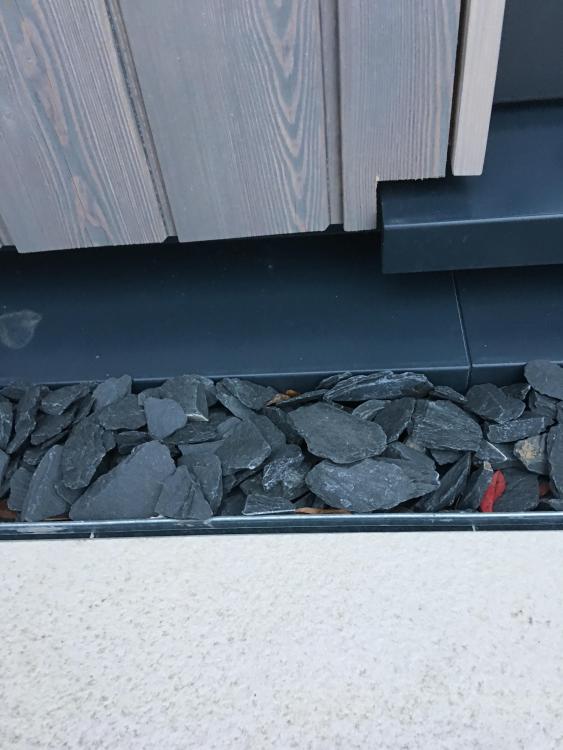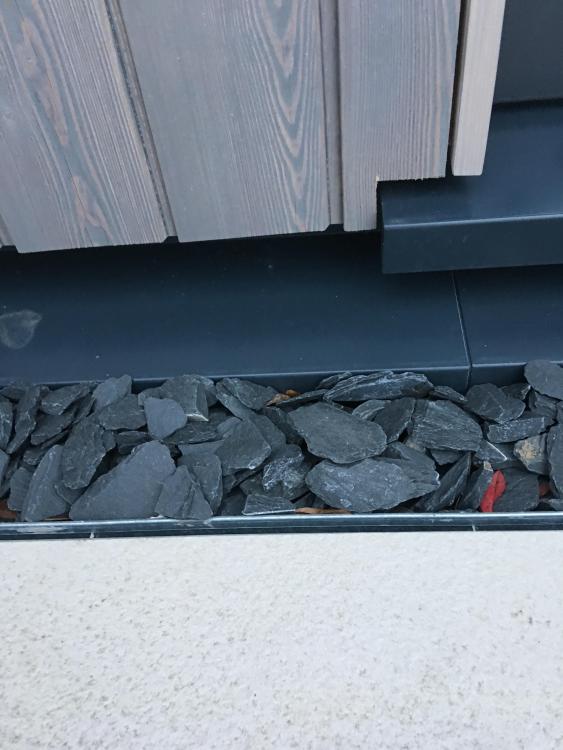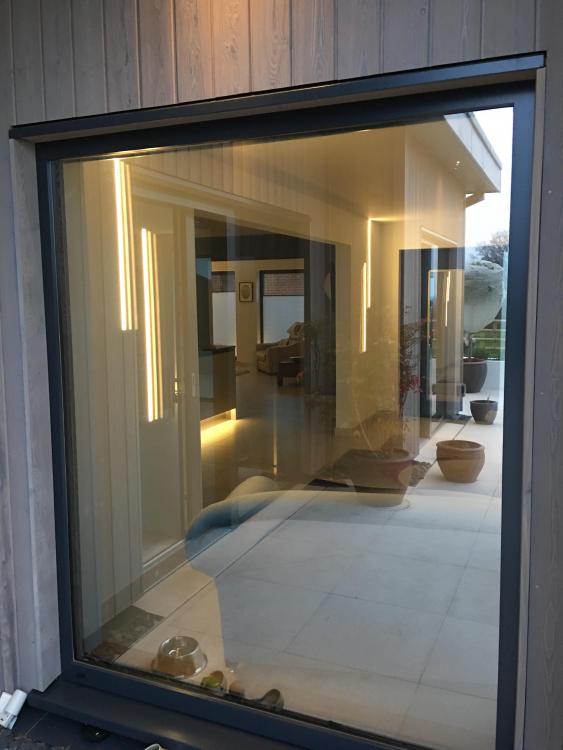Leaderboard
Popular Content
Showing content with the highest reputation on 03/19/19 in all areas
-
Well folks 11 months of living in this house with hellish low humidity not to mention other problems caused by poor mvhr set up finally seem to be sorted. A week on from the change to enthalpy exchanger and rebalancing the system to the guildlines from you guys in here the house feels good to live in for me for the first time since moving in last April. Humidity in living areas running at 39-40 and bedroom at about 42. Temps pretty constant at 22.5- 23. Co2 levels up to between 500-600 as now not overventilating (I never knew there was such a thing!) The house feels much warmer and ufh is not kicking on as much. We are running on my system Level 2 (absent) which is 70% building regs and using Level 3 (living) which is 100% building regs, as bathroom boost. Level 4 blow your socks off rate is now not used. For the first time I now get what you all have been talking about with the MVHR benefit. Got the same people coming back in a few weeks to help sort out the UFH which has never been set up properly. Thank you lovely people I’m grateful for your help.13 points
-
@JSHarris has nothing to feel guilty about, yes he was enthusiastic about the original sunamp because it worked very well, it’s just a shame that the newer model did not and Jeremy has been at the forefront of finding a solution for himself, other forum members and sunamp themselves.2 points
-
To be honest, get an electrician to come and test it. You won't have the test equipment needed.2 points
-
That's exactly what we knocked up for our temporary supply. Went up in 2015 and is still doing the job. Was also useful for storing small tools as well.2 points
-
Well I know what I would do. Fit the indicator and swear blind on a public forum that I had not.......2 points
-
The only thing they might (rightfully) quibble about is having stuff other than their meter in the meter box. Strictly speaking you're only supposed to fit stuff like an earth block, Henley and perhaps a fused isolator inside the meter cabinet, so my small consumer unit and additional cables are a bit naughty. I'm in the process of tidying my cabinet up, by adding a stainless enclosure where the caravan hook up point is, removing the small garage CU that's in the meter box and fitting a new CU inside the stainless box to feed all the external stuff. Rather usefully, I was chatting about doing this to the chap that changed our meter for an E7 one, and he "accidentally" left some unused fuse seals behind...2 points
-
Personally, being a total eccentric I checked the English FAQ! https://www.megabad.com/p/faq#faq_en It gives minimum orders - €2000 - for free delivery to several countries next door to Germany not including the UK, and offers a postage calculator as part of the checkout process, so try that and see what it says. As for O level German, I was taught the basics of propositional logic that way ... Hier is Hans. Hans is NaB ! Bist-du naB, Hans? “Naturlich! Ich stehe unter einem Wasserfall!” F2 points
-
Wire in a 230V old fashioned light bulb with one side on live and the other on the rod. The better the earth the brighter the bulb! I can't condone this as a test method btw...1 point
-
Both Jeremy and nick have always been honest in anything they said about either sunamp or any other item they have been posting about. They call it as they see it with both the good and bad being aired. We are also very lucky to have some one with nicks knowledge about Sunamp available to answer most of the questions that get asked.1 point
-
We used waterproof flooring and just fitted it sans windows.1 point
-
Wow. I would LOVE to hear the technical explanation for this disruption! Thank heavens I didn’t use grey cable clips to fix my 4mm T&E supply cable to the Sunamp controller. Oh, hang on, I did so that’s probably why my Sunamp units failed. ???1 point
-
I've chucked the ball back in their court for now, as if they want to know how their new controller is performing then I need to be able to tell when it's on or off, without lifting the lid and sticking a meter on the contactor...1 point
-
I've been having some correspondence with Sunamp recently, as well as with other Sunamp customers who have had similar issues. The good news is that they are making changes to the controller firmware, that they believe will reduce or remove the failure to charge problem that we have for around 30% of the time. I believe that they have changed the charge acceptance threshold, but I don't know what they've changed it to, and TBH I doubt that it's a fixed value, given the challenges posed by trying to estimate state of charge from just three temperature sensors inside the heat battery (really a cell, IMHO, but they refer to it as a battery). Sunamp are certainly being helpful, and are sending me an updated controller, and have asked if I can assess it's performance. However, this is a Catch 22 request, as they've also said that I can't fit the status light to the new controller... The big problem this presents is that without the status light there is no way to tell whether or not the Sunamp is in the "accepting charge" state, which means that not only can I not compare it to the original controller's performance, but I have no way of knowing whether or not we are likely to run out of hot water the following day. I'm not that confident that they have really grasped the nature of charging a Sunamp from excess PV generation, either, as the suggested fix for having no indicator was to just time how long the Sunamp took to charge. Bit of a tall order when it's charging from variable power PV and you have no way of knowing when the thing is charged... My question about modifying the new controller to fit the absolutely essential status indicator has gone back to their technical people, but I have been given an interim reply that mentions it disrupting the way the controller senses the status of the heat battery, which is, frankly, BS, as the only sense mechanism is the chain of temperature sensors, and they are completely isolated from the heating element contactor (which is all that the indicator mod connects to). I'm really glad that Sunamp are looking at this issue, and have been working on a way to address it, but at the same time I've not got a lot of confidence that they actually know a lot about how either normal excess PV generation systems work, or how they interface with their product. This is completely at odds with the technical people involved in the Sunamp PV, who clearly had an in-depth understanding of what was needed to make best use of PV generation. I'm hopeful that things are looking up. though, and that I will be able to stop going into the services room every morning just to reset the Sunamp so we can be assured of getting hot water the following day.1 point
-
The problem here Jonathan is that the usual sequence of events means that you have to make a decision and action it before you get to the stage where you meet the actual guy tasked by the DNO to do the work. I agree they are generally a pragmatic bunch and more realistic 'on the ground' than the folks sat behind a computer tend to be. Little Britain and 'computer says no' springs to mind.1 point
-
That’s great news @lizzie. Fingers crossed the new guy can sort out the UFH too!1 point
-
Rather than approaching the DNO corporate body and looking for an official answer can you not contact a named job surveyor for an opinion? During my mains power install I always talked with the guy I met onsite during the initial job assessment survey, he was pragmatic.1 point
-
I got mine from Amazon, free delivery https://smile.amazon.co.uk/gp/product/B01CC6UNZG/ref=oh_aui_search_asin_title?ie=UTF8&psc=1 Around £125 so not as cheap as @Ferdinand but a big improvement on £3501 point
-
I bought our meter box from these people: https://www.meterboxesdirect.co.uk/ About £40 or so. The stainless steel IP65 wall box I've recently bought, which is going to house the new CU, only cost about £80.1 point
-
The TBS doesn't need to be in a fancy £600 meter box - you could rattle together a small enclosure from just about anything lying about - it just wants to be solid enough it won't blow away and rainproof. Often a 4x4 fence post, concreted in securely with a piece of plywood screwed to it as a backer and an IP rated enclosure big enough to contain all the bits would be fine. Or get a sheet of ply and knock up a simple box with a door and shed roofing felt over it. Look about, you may even be able to re-purpose something, crying out loud now I think about it for £200 you could get a cheap shed!1 point
-
I’m not absolutely clear on what the issue is but if I have it right its the gap between first and second floor windows? I’m single storey but think the same priciples apply. At the top I have a metal header to match the windows and the vertical cladding comes down flush to that, have a matching piece of cladding across sitting under the header to make it look neat. At the bottom it is just cut off in a straight line all around and sits off the griund.1 point
-
I would say take the time to check out a few others, just to be sure. You may be able to find one which includes your wall mount track. Would your local BM price match to that extent? Ferdinand1 point
-
With my temporary supply I hung a cavity box on two round fence posts within a metre of the garage wall it was going to be put in, when the garage was built I moved the whole meter box into the hole left in the garage wall and got my electrician to connect it up ?, I also did all the digging on site, they just left me a roll of hazard tape to put above the cable when I back filled the trench .1 point
-
1 point
-
@lizzie, wonderful. Hopefully soon, and with you new furry-friend ensconced, and with just the UFH now to tweak, you will at last be able to put house issues behind you and really enjoy your truly lovely home. Just in time to do it all over again with your new build in south Wales (although with smooth sailing this time).1 point
-
If all that is on top of the cost of the connection, then I would do as @ProDave advised and go with a temporary housing. You can get them cheap enough and then mount it into a wall or feature later behind the gates. It’s all in your control then. Why are you having to dig under concrete out of interest ..?1 point
-
@ProDave mentions DNOs not being fussy, equally though the opposite can apply. The only way you can find out what will be accepted is by speaking to your DNO. Everyone can say what they did but it may be about as much use as a chocolate teapot to you if your DNO won't accept it. FWIW I built a permanent kiosk - but the DNO gave specific instructions on what is acceptable - even going so far as to sending me a CAD drawing of an acceptable design! You're looking at the best part of £2000 as is....I'd say that's a bargain compared to bills some get stung with. I'm sure I've seen 21k banded about on here by someone. Speak to the DNO. Not sure how yours works, I had an engineer I could contact - very helpful chap.1 point
-
The ideal (cheapest) sequence of events is to get the foundations dug and the concrete poured, then schedule the DNO power grid hook-up bringing the meterbox right up to the wall near its final cavity wall mounting position. With careful positioning of the meterbox on stilts there will be enough spare cable to lift the meter directly into the wall without further £ bills. Buildhubbers with larger plots seem to favour a dedicated services meter housing near the plot boundary and then total control over subsequent services re routing within the plot as the build progresses.1 point
-
£50 ! That must be a posh meter box made from certified locally sourced recycled plastic? These cavity wall boxes are pretty flimsy when on stilts but that is what the DNO provided as part of the £1200 connection.1 point
-
Yes that is all https://www.ebay.co.uk/itm/SURFACE-MOUNTED-ELECTRIC-METER-BOX/202596025500?hash=item2f2baa049c:g:HzMAAOSwbrZcZDsY1 point
-
For £1200 my power company did the following: Created a new supply spur on the boundary of my self build neighbour's plot so no road closure. * Pulled a cable through 45m of trenched ducting organized my me, this crossed the neighbours plot and mine. Installed slim (** cavity wall sized) meter box on stilts next to the utility room foundation with enough spare cable to allow the meter box to be eventually lifted as-is into the cavity wall. * Some of my supply cable runs over ground on the neighbour's plot and will be sunk free or charge by DNO once he has finalized the position of his foundation plan. ** They arrived with a standard fat meterbox for the job but were generous enough to pop back to the depot when I mentioned my plan to lift the meter directly into the cavity wall later. The trenched ducting organized by me was part of a larger job costing £600 which included concrete foundation pour supervision and labour over 2 days, some digger work for a builders water supply and 10m of foul drain across my garden, so call it £150 for the mains trench part of the job. British Gas supplied and fitted the meter free of charge. For £140 an electrician fitted a temporary 2 x RCD fuse box inside the meter box then supplied and connected 40? amp armoured cable to the static caravan. He was working at my other self build neighbour's house so I laid the 25m of armoured cable between meter box through foundation trenches to the static before he started the live connection work each end of the cable. So all told a live temporary socket next to the meterbox at the house wall would have been about £1200 (DNO) + £150(Trench & Ducting) + £80 (Fit RCDs and earthing pin).1 point
-
Should be okay as long as it is sound. SSE up here are not very fussy if they know it is a temporary supply, I have seen a kitchen cabinet on a post with a bit or roofing felt tacked over it and they put the supply head and meter in that1 point
-
Either option is possible, If you keep the meter there, you have to install a switch fuse and your own steel wire armoured cable into the house to connect to your consumer unit. Or later you can choose to have the supply relocated into the house. for that you will have to pay the DNO to supply the extra cable, do an underground joint and move the supply into the house. You can save money by digging the trench ready for the DNO. Sounds like a good plan to get it in now while the road is open.1 point
-
Yikes! What a mess. Hopefully someone on here can offer some help. Good luck. Is this something those tv programmes could help with - Rogue Traders?1 point
-
@lizzie I'm so glad you've got it sorted and are now comfortable in the house. Hope you are as successful with the UFH.1 point
-
Meter box. Buy and install your own attached to a post concreted in the ground. WAY cheaper than £600 Do ALL the digging on your own land yourself, and lay a duct with a draw string for them to pull their cable through and up into your meter box. By doing the above I save £1000 Re the earth, That is normally done at the connection pit for the permanent supply. But for a building supply you should not use the suppliers earth you should install your own TT earth (an earth rod or rods) The electrician that connects your site consumer unit and site sockets will be able to bang a rod in for that. Don't ask the DNO to provide the building site earth. Before you commit though what are your plans for the final supply? Leave it there (as many of us have done) or pay to get it moved into the house?1 point
-
This is a post that's full of pain. I'm left a bit stunned, and wishing that you had found us in early 2014 - heartily wishing you'd found us much earlier. What do you propose to do now? Please tell us and we'll give you at least a sympathetic ear, but also a series of things you can do to protect yourself from further ' damage '1 point
-
Whenever you get that feeling. "that's going to hit me" /"that's going to slip and cut me" /"ill trip over that later" /"I bet there's a pipe or cable behind there" Listen to that feeling.1 point
-
We went through all the "fun" of buying a new FF for the new kitchen, we didn't want anything as big as the American FF's wanted an upright fridge above freezer. The only one that cut it was a Becko that was 700mm wide. Almost all of the uprights are only 600mm wide and did not seem big enough. Unfortunately the Becko is noisy, not only is the compressor noise more than I would have liked, but it creaks and cracks as it is cooling. Not so bad now we have the separate living room so I don't have to put up with it's noise while having a peaceful evening. It's a shame you can't view FF's in a "listening room" like a decent hifi shop so you could turn your chosen model on and hear what it really sounds like. The LG side by side American FF that we had at the old house I have to say was one of the quietest FF's I have ever heard.1 point
-
Well I put red dye along the lane floor right next to my wall . 2 bucket falls . No sign of any red inside yet . Yesterday I mixed some cement and filled any holes in the stone work .1 point
-
The title had me worried for a bit there @lizzie...... It's always good to solve a seemingly intractable problem. Time to enjoy it now! Ian1 point
-
Hello and welcome.......first thought what about budget over run/contingency have you factored that in to your costings. Essentially from what you say if i read it correctly it looks as though you have what amounts to a 400k£ building plot fully mortgaged and want to borrow to build with little or no equity in the plot and a relatively small amount of savings against the overall cost. Your savings of 170k seem to be approx 20% of your overall costings 400 plot 400 build......from your final value figure it looks like the third/third/third ratio which has recently been debated on this forum. If you were buying a ready built property for 800k and put your 20% down that would get you back to your affordability of 630k but building loans dont work that way.....nor sadly does the now mythical third profit ratio. It appears from what you say you have a plot with possibly little equity so not much security for the lender to advance funds against to build. In the majority of cases the plot is purchased outright and a mortgage taken for the build so that could be why Buildstore wont help you. If you have a decent amount of equity in the plot then that may help. Have you spoken to the people you have your current mortgage with (they will need to give permision for you to demolish their asset) or your bank......or a good broker with expertise in this area? Apologies if I have misunderstood your scenario and good luck.1 point
-
Foam sticks to Foil on the PIR with no problems.1 point
-
Ja, @Ferdinand, aber die Frage war fur Minimum Bestellung ... nicht Kostenlose Bestellung.. Quatschkopf Du...?1 point
-
1 point
-
? borrow one off someone willing to tie up thousands of pounds of capital in tools they only use once or twice a year. Seriously we’re all doing this very very wrong. ?1 point
-
All those tips you gave me haven't worked. I think you're a better glider than a teacher.1 point
-
Even some of our floors that were screwed down squeak (although far less than the ones that didn't get screws). The glue is the key, imo. I believe Egger board suggest only fixing one end of their boards with screws and using adhesive-only everywhere else.1 point
-
I have always put the cheapest extractor hoods I could find into kitchens as I never remember to use the things. Then in the last build, we had the hob on a penisular with a breakfast bar behind and we needed the extractor hood for building regs. So I bought one of the things that rises out of the worktop. It was great and caused no end of amusement. Not sure it worked particularly well and from memory was over £2k but I do love a gadget. It could be set to extract outside or to recirculate and we chose the extract out route. The main reason for choosing this type of extractor was that Peter is forever bashing his head on anything and everything. Most island cooker hoods are within range (albeit with a bit of effort) of his head, he is not very tall, just creative when it comes to hurting himself. Add that to the weight on the ceiling - in that house I was concerned about that additional weight in a central part of the ceiling which had a very wide span - a rising extractor seemed sensible. I can see that the price has come down now and there is one on here for just over £1k at the moment (10% off with save10) voucher) https://www.theappliancedepot.co.uk/brand-new-de-dietrich-dhd1500dg-86cm-dark-grey-premium-downdraft-extractor?gclid=EAIaIQobChMIrs22gvOI4QIVir3tCh0X4g5kEAQYAyABEgKYWvD_BwE So it seems likely we will be using the same type of system again.1 point
-
Something like mine? Took some working out: Timber frame covered with moisture resistant pkasterboard generally and Aqua Panel in the wet room corner and behind the wc: NB: Aqua Panel is a whole different ball game to mrpb. Pretty much inflexible by comparison and cracks quite easily so get your studs dead flush. Dusty (old circular saw and carbide edged jigsaw blades) to cut and needs special screws. The bottom "shelf" of the Aqua Panel (where the beer is above ) projects over the wall panel that comes up to it. When all the boarding was done I tanked the pocket with the blue stuff, Aqua Seal in this case. This is the 10mm white pvc trim I used for 8mm tiles. I went for the tile flush with the trim so you don't feel the trim edge: Trim on. I stuck mine on with clear CT1. @Nickfromwalesfavours mitre bond but I couldn't get on with it: (I wanted chrome or stainless trim btw but was overruled ) Back tiles on first - sits behind the bottom tile btw: Bottom tile in second, mine slope toward the front by a few degrees. A bit of plastic helps to check the fit and get the tile out again: Then the top: Then the sides last. See the sloping bottom tile? Note the 1mm shims all round. I take no credit for the majority of this. Mainly done with advice from @Nickfromwales. Standing on the shoulders of giants me!1 point
-
I’m clearly going to side with the wife ?. I read into @JSHarris’ post that he had borrowed against his old house and not against the new house at all. Thus once he sold the old house he was mortgage free and didn’t ever need a mortgage on the new house. Remortgaging is clearly easier than getting a self build mortgage but you have to have enough equity in the house plus savings to complete your build otherwise you could end up with a shortfall. That said, rather than borrowing extra, some people live in a static or move in before the build is finished in order to complete the build slowly as and when they can afford it from their earnings. Remember also that if you want to take out a mortgage on the new house after it is built you will likely need to take out a warranty on the house. @paulc313 I am a bit confused by your figures. You say you have 90k equity plus 35k savings so 125k of your own once your old house sells. The plot is 85k and you should be able to build it for 220k. So a total of 305k all in. Does that include all fees, architects, structural engineers, connection of services, site insurance, warranty etc or just the actual build work? If you put the 35k towards the plot that means that your FIL needs to find 270k to complete the build assuming that you don’t sell straightaway. Would your FIL be able to raise a mortgage of that size? Once you sell that leaves a potential shortfall of 180k that you will need to get a mortgage on the new house for once complete in order to pay off your FIL’s mortgage. Are you proposing to pay your FIL’s mortgage so he doesn’t incur the interest? Would mean you paying 2 mortgages though until you have sold your existing house. In addition if your FIL is VAT registered he can complete the work on a supply and fit basis with zero vat. If not you will need to buy all materials and reclaim the vat on them meaning that you will need extra cash available until the reclaim is complete to cover the vat on materials.1 point
This leaderboard is set to London/GMT+01:00




















.jpg.c21f3ac78c9b7efd90cbdcb312744dc5.thumb.jpg.7adcad4c0e384f5ecd7d56b0618df6e5.jpg)